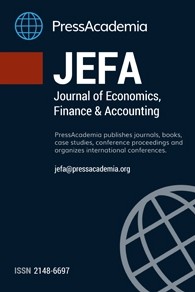COMPARISON OF THE ACCURACY OF MODELS IN FORECASTING VAR AND ES THROUGH TIME
COMPARISON OF THE ACCURACY OF MODELS IN FORECASTING VAR AND ES THROUGH TIME
VaR, ES, parametric, semi-parametric, backtesting, probability distribution rolling-window,
___
- Abad, P., Benito, S. & Lopez C. (2014) A comprehensive review of Value at Risk methodologies. The Spanish Review of Financial Economics 12, 15-32.
- Adcock, C., Eling, M. & Loperfido, N. (2012). Skewed distributions in finance and actuarial science: a review. The European Journal of Finance, 4, 1-29.
- Angelidis, T., Benos, A. & Degiannakis, S. (2007). A robust VaR model under different time periods and weighting schemes. Review of Quantitative Finance and Accounting, 28, 187-201.
- Artzner, P., Delbaen, F., Eber, J. & Heath, D. (1997). Thinking coherently. Risk, 10(11), 68-71.
- Artzner, P., Delbaen, F., Eber, J. & Heath, D. (1999). Coherent measures of risk. Mathematical Finance, 9, 203-228.
- Bali, T. G. & Theodossiou, P. (2008). Risk measurement performance of alternative distribution functions. The Journal of Risk and Insurance 75, 411-437.
- Bali, T. G. & Weinbaum, D. (2007). A conditional extreme value volatility estimator based on high-frequency returns. Journal of Economic Dynamics and Control, 31, 361-397.
- Bali, T., Mo, H. & Tang, Y. (2008). The role of autoregressive conditional skewness and kurtosis in the estimation of conditional VAR. Journal of Banking and Finance, 32, 269-282.
- Bali, T. & Theodossiou, P. (2007). A conditional-sgt-var approach with alternative GARCH models. Annals of Operations Research, 151(1), 241-267.
- Balkema, A. A. & de Haan, L. (1974). Residual lifetime at great age. Annals of Probability, 2, 792-804.
- Campbell, S. (2005), A review of backtesting and backtesting procedures. Finance and Economics Discussion Series. Washington, DC: Federal Reserve Board.
- Chen, C., Gerlach, R., Lin, E. & Lee, W. (2011). Bayesian forecasting for financial risk management, pre and post the global financial crisis. Journal of Forecasting, 31(8), 661-687.
- Christoffersen, P. (1998). Evaluating interval forecasts. International Economic Review, 39, 841-862.
- Down, K. (2002), Measuring market risk, John Wiley and Sons, Chichester.
- DuMouchel, W. (1983). Estimating the stable index in order to measure tail thickness: a critique. Annals of Statistics, 11(3), 1019-1031.
- Embrechts, P., Kluppelberg, C. & Mikosch, T. (1997). Modelling extremal events for insurance and finance, Springer, Berlin.
- Engle, R. & Manganelli, S. (2004). Caviar: Conditional autoregressive value at risk by regression quantiles. Journal of Business and Economic Statistics, 22, 367-381.
- Gilli, M. & Kezi, E. (2006). An application of extreme value theory for measuring financial risk. Computational Economics, 27(2), 207-228.
- Giot, P. & Laurent, S. (2003). Value-at-risk for long and short trading positions. Journal of Applied Econometrics, 18, 641-663.
- Giot, P. & Laurent, S. (2004). Modelling daily value-at-risk using realized volatility and arch type models. Journal of Empirical Finance, 11, 379-398.
- Glosten, L. R., Jagannathan, R. & Runkle, D. E. (1993). On the relation between the expected value and the volatility of the nominal excess return on stocks. The Journal of Finance, 5, 1779-1801.
- Gonzalez-Rivera, G., Lee, T. & Mishra, S. (2004). Forecasting volatility: a reality check based on option pricing, utility function, value-at-risk, and predictive likelihood. International Journal of Forecasting, 20, 629-645.
- Haas, M., Mittnik, S. & Paolella, M. (2004). Mixed normal conditional heteroskedasticity. Journal of Financial Econometrics, 2, 211-250.
- Huang, Y. & Lin, B. (2004). Value-at-risk analysis for Taiwan stock index futures: fat tails and conditional asymmetries in return innovations. Review of Quantitative Finance and Accounting, 22, 79-95.
- McNeil, A. & Frey, R. (2000). Estimation of tail-related risk measures for heteroscedastic financial time series: An extreme value approach. Journal of Empirical Finance, 7, 271-300.
- McNeil, A., Frey, R. & Embrechts, P. (2005). Quantitative risk management: Concepts, techniques, and tools. Princeton Series in Finance. Princeton University Press.
- Mittnik, S. & Paolella, M. (2000). Conditional density and value-at-risk prediction of Asian currency exchange rates. Journal of Forecasting, 19, 313-333.
- Nelson, D. (1991). Conditional heteroskedasticity in asset returns: a new approach. Econometrica, 59, 347-370.
- Niguez, T.-M. (2008). Volatility and VaR forecasting in the Madrid stock exchange. Spanish Economic Review, 10, 169-196.
- Pickands, J. (1975). Statistical inference using extreme order statistics. Annals of Statistics, 3, 119-131.
- Smith, R. (1989). Extreme value analysis of environmental time series: An application to trend detection in ground-level ozone. Statistical Science, 4, 367-393.
- Zakoian, J. M. (1994). Threshold heteroskedastic models. Journal of Economic Dynamics and Control, 18 (5), 931-955.
- Zhang, Y. & Nadarajah, S. (2018). A review of backtesting for value at risk. Communications in Statistics Theory and Methods, 47 (15) ,3616-3639
- Yayın Aralığı: Yılda 4 Sayı
- Başlangıç: 2014
- Yayıncı: PressAcademia
THE ROLE OF REAL EARNINGS MANAGEMENT IN THE VALUE RELEVANCE OF ACCOUNTING INFORMATION IN INDONESIA
THE EFFECT OF MONETARY POLICY SHOCKS ON INDUSTRIAL OUTPUT IN AFGHANISTAN
COMPARISON OF THE ACCURACY OF MODELS IN FORECASTING VAR AND ES THROUGH TIME
THE IMPORTANCE OF EFFICIENCY FOR LIFE INSURER PROFIT REGARDING CANADIAN LIFE INSURERS
DOES PUBLIC DEBT IMPEDE FINANCIAL DEVELOPMENT IN JORDAN? SOME MACRO AND MICRO ANALYSES
